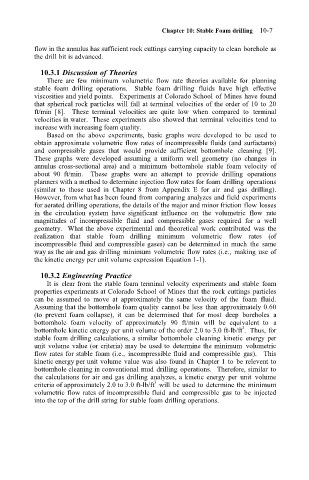Page 482 - Air and Gas Drilling Manual
P. 482
flow in the annulus has sufficient rock cuttings carrying capacity to clean borehole as
the drill bit is advanced.
10.3.1 Discussion of Theories Chapter 10: Stable Foam drilling 10-7
There are few minimum volumetric flow rate theories available for planning
stable foam drilling operations. Stable foam drilling fluids have high effective
viscosities and yield points. Experiments at Colorado School of Mines have found
that spherical rock particles will fall at terminal velocities of the order of 10 to 20
ft/min [8]. These terminal velocities are quite low when compared to terminal
velocities in water. These experiments also showed that terminal velocities tend to
increase with increasing foam quality.
Based on the above experiments, basic graphs were developed to be used to
obtain approximate volumetric flow rates of incompressible fluids (and surfactants)
and compressible gases that would provide sufficient bottomhole cleaning [9].
These graphs were developed assuming a uniform well geometry (no changes in
annulus cross-sectional area) and a minimum bottomhole stable foam velocity of
about 90 ft/min. These graphs were an attempt to provide drilling operations
planners with a method to determine injection flow rates for foam drilling operations
(similar to those used in Chapter 8 from Appendix E for air and gas drilling).
However, from what has been found from comparing analyzes and field experiments
for aerated drilling operations, the details of the major and minor friction flow losses
in the circulation system have significant influence on the volumetric flow rate
magnitudes of incompressible fluid and compressible gases required for a well
geometry. What the above experimental and theoretical work contributed was the
realization that stable foam drilling minimum volumetric flow rates (of
incompressible fluid and compressible gases) can be determined in much the same
way as the air and gas drilling minimum volumetric flow rates (i.e., making use of
the kinetic energy per unit volume expression Equation 1-1).
10.3.2 Engineering Practice
It is clear from the stable foam terminal velocity experiments and stable foam
properties experiments at Colorado School of Mines that the rock cuttings particles
can be assumed to move at approximately the same velocity of the foam fluid.
Assuming that the bottomhole foam quality cannot be less than approximately 0.60
(to prevent foam collapse), it can be determined that for most deep boreholes a
bottomhole foam velocity of approximately 90 ft/min will be equivalent to a
3
bottomhole kinetic energy per unit volume of the order 2.0 to 3.0 ft-lb/ft . Thus, for
stable foam drilling calculations, a similar bottomhole cleaning kinetic energy per
unit volume value (or criteria) may be used to determine the minimum volumetric
flow rates for stable foam (i.e., incompressible fluid and compressible gas). This
kinetic energy per unit volume value was also found in Chapter 1 to be relevent to
bottomhole cleaning in conventional mud drilling operations. Therefore, similar to
the calculations for air and gas drilling analyzes, a kinetic energy per unit volume
3
criteria of approximately 2.0 to 3.0 ft-lb/ft will be used to determine the minimum
volumetric flow rates of incompressible fluid and compressible gas to be injected
into the top of the drill string for stable foam drilling operations.

